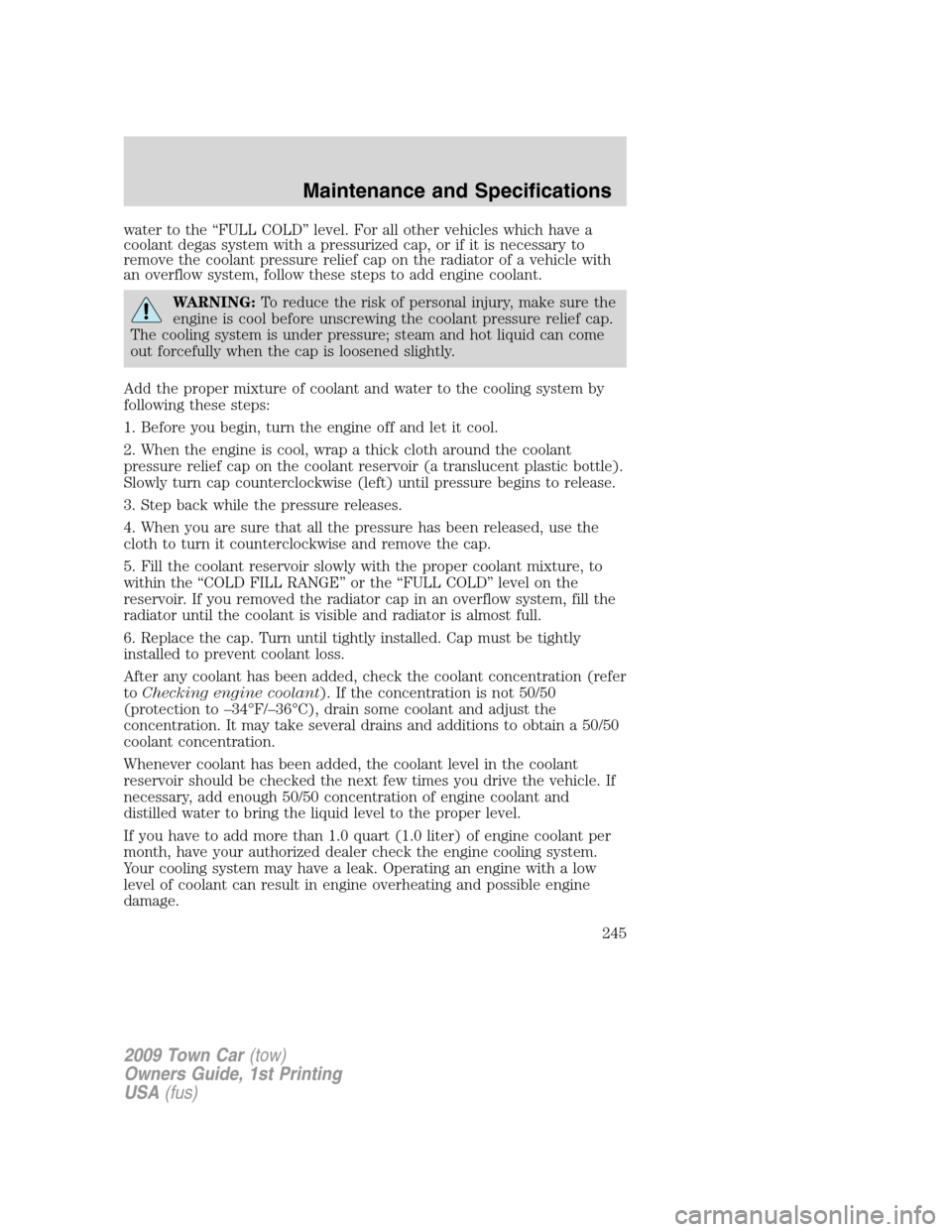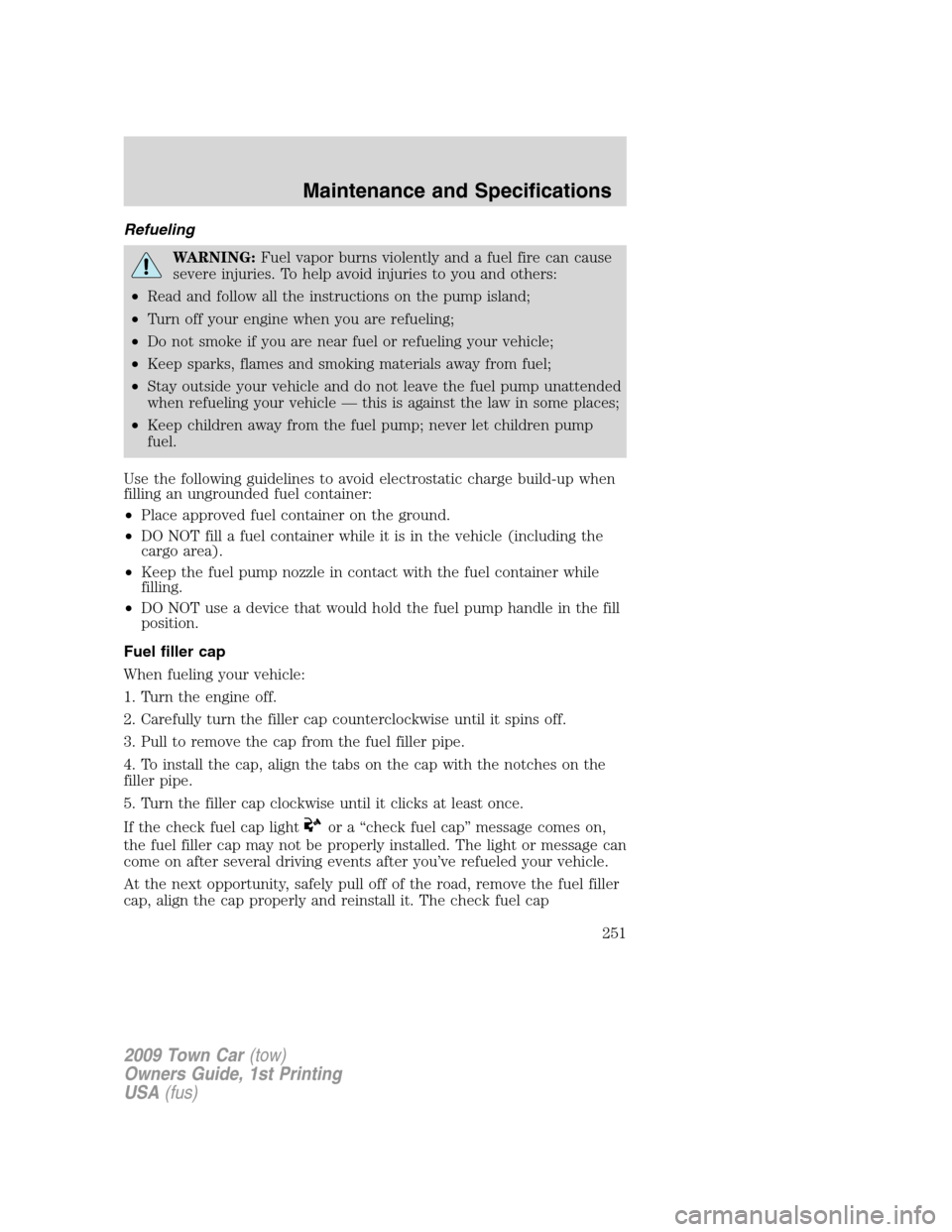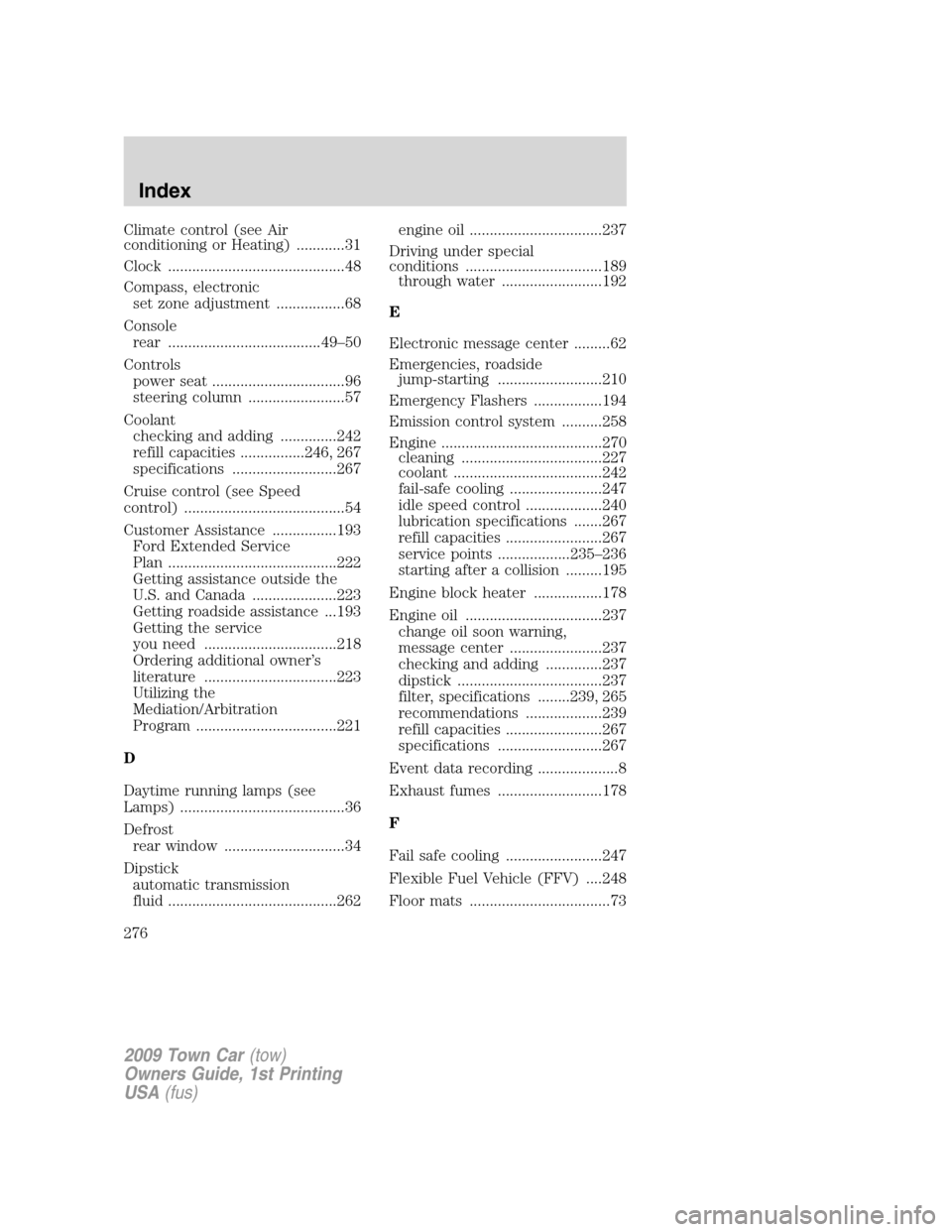Page 245 of 280

water to the “FULL COLD” level. For all other vehicles which have a
coolant degas system with a pressurized cap, or if it is necessary to
remove the coolant pressure relief cap on the radiator of a vehicle with
an overflow system, follow these steps to add engine coolant.
WARNING:To reduce the risk of personal injury, make sure the
engine is cool before unscrewing the coolant pressure relief cap.
The cooling system is under pressure; steam and hot liquid can come
out forcefully when the cap is loosened slightly.
Add the proper mixture of coolant and water to the cooling system by
following these steps:
1. Before you begin, turn the engine off and let it cool.
2. When the engine is cool, wrap a thick cloth around the coolant
pressure relief cap on the coolant reservoir (a translucent plastic bottle).
Slowly turn cap counterclockwise (left) until pressure begins to release.
3. Step back while the pressure releases.
4. When you are sure that all the pressure has been released, use the
cloth to turn it counterclockwise and remove the cap.
5. Fill the coolant reservoir slowly with the proper coolant mixture, to
within the “COLD FILL RANGE” or the “FULL COLD” level on the
reservoir. If you removed the radiator cap in an overflow system, fill the
radiator until the coolant is visible and radiator is almost full.
6. Replace the cap. Turn until tightly installed. Cap must be tightly
installed to prevent coolant loss.
After any coolant has been added, check the coolant concentration (refer
toChecking engine coolant). If the concentration is not 50/50
(protection to –34°F/–36°C), drain some coolant and adjust the
concentration. It may take several drains and additions to obtain a 50/50
coolant concentration.
Whenever coolant has been added, the coolant level in the coolant
reservoir should be checked the next few times you drive the vehicle. If
necessary, add enough 50/50 concentration of engine coolant and
distilled water to bring the liquid level to the proper level.
If you have to add more than 1.0 quart (1.0 liter) of engine coolant per
month, have your authorized dealer check the engine cooling system.
Your cooling system may have a leak. Operating an engine with a low
level of coolant can result in engine overheating and possible engine
damage.
2009 Town Car(tow)
Owners Guide, 1st Printing
USA(fus)
Maintenance and Specifications
245
Page 251 of 280

Refueling
WARNING:Fuel vapor burns violently and a fuel fire can cause
severe injuries. To help avoid injuries to you and others:
•Read and follow all the instructions on the pump island;
•Turn off your engine when you are refueling;
•Do not smoke if you are near fuel or refueling your vehicle;
•Keep sparks, flames and smoking materials away from fuel;
•Stay outside your vehicle and do not leave the fuel pump unattended
when refueling your vehicle — this is against the law in some places;
•Keep children away from the fuel pump; never let children pump
fuel.
Use the following guidelines to avoid electrostatic charge build-up when
filling an ungrounded fuel container:
•Place approved fuel container on the ground.
•DO NOT fill a fuel container while it is in the vehicle (including the
cargo area).
•Keep the fuel pump nozzle in contact with the fuel container while
filling.
•DO NOT use a device that would hold the fuel pump handle in the fill
position.
Fuel filler cap
When fueling your vehicle:
1. Turn the engine off.
2. Carefully turn the filler cap counterclockwise until it spins off.
3. Pull to remove the cap from the fuel filler pipe.
4. To install the cap, align the tabs on the cap with the notches on the
filler pipe.
5. Turn the filler cap clockwise until it clicks at least once.
If the check fuel cap light
or a “check fuel cap” message comes on,
the fuel filler cap may not be properly installed. The light or message can
come on after several driving events after you’ve refueled your vehicle.
At the next opportunity, safely pull off of the road, remove the fuel filler
cap, align the cap properly and reinstall it. The check fuel cap
2009 Town Car(tow)
Owners Guide, 1st Printing
USA(fus)
Maintenance and Specifications
251
Page 276 of 280

Climate control (see Air
conditioning or Heating) ............31
Clock ............................................48
Compass, electronic
set zone adjustment .................68
Console
rear ......................................49–50
Controls
power seat .................................96
steering column ........................57
Coolant
checking and adding ..............242
refill capacities ................246, 267
specifications ..........................267
Cruise control (see Speed
control) ........................................54
Customer Assistance ................193
Ford Extended Service
Plan ..........................................222
Getting assistance outside the
U.S. and Canada .....................223
Getting roadside assistance ...193
Getting the service
you need .................................218
Ordering additional owner’s
literature .................................223
Utilizing the
Mediation/Arbitration
Program ...................................221
D
Daytime running lamps (see
Lamps) .........................................36
Defrost
rear window ..............................34
Dipstick
automatic transmission
fluid ..........................................262engine oil .................................237
Driving under special
conditions ..................................189
through water .........................192
E
Electronic message center .........62
Emergencies, roadside
jump-starting ..........................210
Emergency Flashers .................194
Emission control system ..........258
Engine ........................................270
cleaning ...................................227
coolant .....................................242
fail-safe cooling .......................247
idle speed control ...................240
lubrication specifications .......267
refill capacities ........................267
service points ..................235–236
starting after a collision .........195
Engine block heater .................178
Engine oil ..................................237
change oil soon warning,
message center .......................237
checking and adding ..............237
dipstick ....................................237
filter, specifications ........239, 265
recommendations ...................239
refill capacities ........................267
specifications ..........................267
Event data recording ....................8
Exhaust fumes ..........................178
F
Fail safe cooling ........................247
Flexible Fuel Vehicle (FFV) ....248
Floor mats ...................................73
2009 Town Car(tow)
Owners Guide, 1st Printing
USA(fus)
Index
276
Page:
< prev 1-8 9-16 17-24